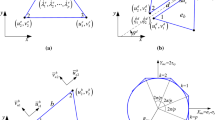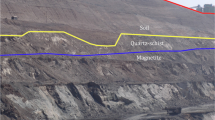Abstract
Geotechnical stability analyses based on classical continuum may lead to remarkable underestimations on geotechnical safety. To attain better estimations on geotechnical stability, the micro-polar continuum is employed so that its internal characteristic length (4) can be utilized to model the shear band width. Based on two soil slope examples, the role of internal characteristic length in modeling the shear band width of geomaterial is investigated by the second-order cone programming optimized micro-polar continuum finite element method. It is recognized that the underestimation on factor of safety (FOS) calculated from the classical continuum tends to be more pronounced with the increase of 4. When the micro-polar continuum is applied, the shear band dominated by 4 is almost kept unaffected as long as the adopted meshes are fine enough, but it does not generally present a slip surface like in the cases from the classical continuum, indicating that the micro-polar continuum is capable of capturing the non-local geotechnical failure characteristic. Due to the coupling effects of 4 and strain softening, softening behavior of geomaterial tends to be postponed. Additionally, the bearing capacity of a geotechnical system may be significantly underestimated, if the effects of 4 are not modeled or considered in numerical analyses.
摘要
基于经典连续体理论的岩土体稳定性分析可能会显著低估岩土体的安全性。为了更好地评价岩 土体稳定性, 采用微极连续体, 以便其内部特征长度(lc)能够模拟剪切带宽度。以两个边坡为例, 基于 二阶锥规划的微极连续体有限元法, 研究内部特征长度在模拟岩土材料剪切带宽度中的作用。结果表 明, 随着lc 的增加, 对由经典连续体计算的FOS 的低估更加明显。当应用微极连续体时, 只要采用足 够细的网格, 剪切带受lc 主导基本保持不变, 所呈现的滑裂面与经典连续体不同, 表明微极连续体能 够捕捉非局部岩土破坏特征。由于lc 和应变软化的耦合作用, 岩土材料的软化行为有所滞后。此外, 如果在数值分析中不模拟或不考虑lc 的影响, 岩土体系的承载力可能会被严重低估。
Similar content being viewed by others
Explore related subjects
Discover the latest articles and news from researchers in related subjects, suggested using machine learning.References
GRIFFITHS D V, LANE P A. Slope stability analysis by finite elements [J]. Géotechnique, 1999, 49(3): 387–403. DOI: https://doi.org/10.1680/geot.1999.49.3.387.
ZHAO Lian-heng, LI Liang, YANG Feng, LUO Qiang, LIU Xiang. Upper bound analysis of slope stability with nonlinear failure criterion based on strength reduction technique [J]. Journal of Central South University of Technology, 2010, 17(4): 836–844. DOI: https://doi.org/10.1007/s11771-010-564-7.
KRABBENHOFT K, LYAMIN A V. Strength reduction finite-element limit analysis [J]. Géotechnique Letters, 2015, 5(4): 250–253. DOI: https://doi.org/10.1680/jgele.15.00110.
DENG Dong-ping, LI Liang, ZHAO Lian-heng. Limit equilibrium analysis for stability of soil nailed slope and optimum design of soil nailing parameters [J]. Journal of Central South University, 2017, 24(11): 2496–2503. DOI: https://doi.org/10.1007/s11771-017-3662-y.
LIU Yong, ZHANG Wen-gang, ZHANG Lei, ZHU Zhi-ren, HU Jun, WEI Hong. Probabilistic stability analyses of undrained slopes by 3D random fields and finite element methods [J]. Geoscience Frontiers, 2018, 9(6): 1657–1664. DOI: https://doi.org/10.1016/j.gsf.2017.09.003.
ZHANG Rui, LONG Ming-xu, LAN Tian, ZHENG Jian-long, GEOFF C. Stability analysis method of geogrid reinforced expansive soil slopes and its engineering application [J]. Journal of Central South University, 2020, 27(7): 1965–1980. DOI: https://doi.org/10.1007/s11771-020-4423-x.
CHEN X, WU Yong-kang, YU Yu-zhen, LIU Jian-kun, XU X F, REN Jun. A two-grid search scheme for large-scale 3-D finite element analyses of slope stability [J]. Computers and Geotechnics, 2014, 62: 203–215. DOI: https://doi.org/10.1016/j.compgeo.2014.07.010.
TSCHUCHNIGG F, SCHWEIGER H F, SLOAN S W. Slope stability analysis by means of finite element limit analysis and finite element strength reduction techniques. Part II: Back analyses of a case history [J]. Computers and Geotechnics, 2015, 70: 178–189. DOI: https://doi.org/10.1016/j.compgeo.2015.06.018.
WANG Dong-yong, CHEN Xi, YU Yu-zhen, JIE Yu-xin, LYU Yan-nan. Stability and deformation analysis for geotechnical problems with nonassociated plasticity based on second-order cone programming [J]. International Journal of Geomechanics, 2019, 19(2): 04018190. DOI: https://doi.org/10.1061/(ASCE)GM.1943-5622.0001339.
MÜHLHAUS H B, VARDOULAKIS I. The thickness of shear bands in granular materials [J]. Géotechnique, 1987, 37(3): 271–283. DOI: https://doi.org/10.1680/geot.1987.37.3.271.
TEJCHMAN J, WU W. Numerical study on patterning of shear bands in a Cosserat continuum [J]. Acta Mechanica, 1993, 99(1–4): 61–74. DOI: https://doi.org/10.1007/BF01177235.
TEJCHMAN J, WU W. Numerical simulation of shear band formation with a hypoplastic constitutive model [J]. Computers and Geotechnics, 1996, 18(1): 71–84. DOI: https://doi.org/10.1016/0266-352X(96)00004-3.
GRACIO J J. The double effect of grain size on the work hardening behaviour of polycrystalline copper [J]. Scripta Metallurgica et Materialia, 1994, 31(4): 487–489. DOI: https://doi.org/10.1016/0956-716X(94)90024-8.
SHARBATI E, NAGHDABADI R. Computational aspects of the Cosserat finite element analysis of localization phenomena [J]. Computational Materials Science, 2006, 38(2): 303–315. DOI: https://doi.org/10.1016/j.commatsci.2006.03.003.
VOYIADJIS G Z, ALSALEH M I, ALSHIBLI K A. Evolving internal length scales in plastic strain localization for granular materials [J]. International Journal of Plasticity, 2005, 21(10): 2000–2024. DOI: https://doi.org/10.1016/j.ijplas.2005.01.008.
TANG Hong-xiang, SUN Fa-bing, ZHANG Yi-peng, DONG Yan. Elastoplastic axisymmetric Cosserat continua and modelling of strain localization [J]. Computers and Geotechnics, 2018, 101: 159–167. DOI: https://doi.org/10.1016/j.compgeo.2018.05.004.
WANG Dong-yong, CHEN Xi, LV Yan-nan, TANG Chong. Geotechnical localization analysis based on Cosserat continuum theory and second-order cone programming optimized finite element method [J]. Computers and Geotechnics, 2019, 114: 103118. DOI: https://doi.org/10.1016/j.compgeo.2019.103118.
CHANG Jiang-fang, CHU Xi-hua, XU Yuan-jie. Finite-element analysis of failure in transversely isotropic geomaterials [J]. International Journal of Geomechanics, 2015, 15(6): 04014096. DOI: https://doi.org/10.1061/(ASCE)GM.1943-5622.0000455.
CHU J, LO S C R, LEE I K. Strain-softening behavior of granular soil in strain-path testing [J]. Journal of Geotechnical Engineering, 1992, 118(2): 191–208. DOI: https://doi.org/10.1061/(ASCE)0733-9410(1992)118:2(191).
READ H E, HEGEMIER G A. Strain softening of rock, soil and concrete: A review article [J]. Mechanics of Materials, 1984, 3(4): 271–294. DOI: https://doi.org/10.1016/0167-6636(84)90028-0.
CONTE E, SILVESTRI F, TRONCONE A. Stability analysis of slopes in soils with strain-softening behaviour [J]. Computers and Geotechnics, 2010, 37(5): 710–722. DOI: https://doi.org/10.1016/j.compgeo.2010.04.010.
ZHANG Ke, CAO Ping, BAO Rui. Progressive failure analysis of slope with strain-softening behaviour based on strength reduction method [J]. Journal of Zhejiang University SCIENCE A, 2013, 14(2): 101–109. DOI: https://doi.org/10.1631/jzus.A1200121.
RAFIEI RENANI H, MARTIN C D. Factor of safety of strain-softening slopes [J]. Journal of Rock Mechanics and Geotechnical Engineering, 2020, 12(3): 473–483. DOI: https://doi.org/10.1016/j.jrmge.2019.11.004.
LI Xi-kui, TANG Hong-xiang. A consistent return mapping algorithm for pressure-dependent elastoplastic Cosserat continua and modelling of strain localisation [J]. Computers & Structures, 2005, 83(1): 1–10. DOI: https://doi.org/10.1016/j.compstruc.2004.08.009.
REISSNER E. On a variational theorem in elasticity [J]. Journal of Mathematics and Physics, 1950, 29(1–4): 90–95. DOI: https://doi.org/10.1002/sapm195029190.
KRABBENHOFT K, KARIM M R, LYAMIN A V, SLOAN S W. Associated computational plasticity schemes for nonassociated frictional materials [J]. International Journal for Numerical Methods in Engineering, 2012, 90(9): 1089–1117. DOI: https://doi.org/10.1002/nme.3358.
ZHANG X, SHENG Dai-chao, SLOAN S W, BLEYER J. Lagrangian modelling of large deformation induced by progressive failure of sensitive clays with elastoviscoplasticity [J]. International Journal for Numerical Methods in Engineering, 2017, 112(8): 963–989. DOI: https://doi.org/10.1002/nme.5539.
MOSEK, A. The MOSEK C optimizer for API C8.0.0.94 [OB/OL]. [2018-12-25] http://docs.mosek.com/8.0/capi/index.html.
DAVIS, E H. Theories of plasticity and failure of soil masses [M]// Soil Mechanics: Selected Topics, 1968: 341–354.
CHEN Xi, WANG Dong-yong, YU Yu-zhen, LV Yan-nan. A modified Davis approach for geotechnical stability analysis involving non-associated soil plasticity [J]. Géotechnique, 2020, 70(12): 1109–1119. DOI: https://doi.org/10.1680/jgeot.18.p.158.
Author information
Authors and Affiliations
Contributions
CHEN Xi provided the concept and edited the manuscript. WANG Dong-yong performed some analyses and wrote the first draft. TANG Jian-bin performed some analyses and provided some numerical results. MA Wen-chen gave some revision suggestions on the first draft. LIU Yong edited the final revised draft.
Corresponding author
Additional information
Conflict of interest
CHEN Xi, WANG Dong-yong, TANG Jian-bin, MA Wen-chen and LIU Yong declare that they have no conflict of interest
Foundation item
Projects(2017YFC0804602, 2017YFC0404802) supported by the National Key R&D Program of China; Project(2019JBM092) supported by the Fundamental Research Funds for the Central Universities, China
Rights and permissions
About this article
Cite this article
Chen, X., Wang, Dy., Tang, Jb. et al. Geotechnical stability analysis considering strain softening using micro-polar continuum finite element method. J. Cent. South Univ. 28, 297–310 (2021). https://doi.org/10.1007/s11771-021-4603-3
Received:
Accepted:
Published:
Issue Date:
DOI: https://doi.org/10.1007/s11771-021-4603-3
Key words
- slope stability
- strain localization
- non-local geotechnical failure
- micro-polar continuum
- internal characteristic length




